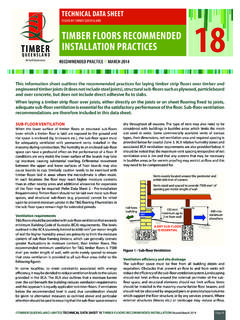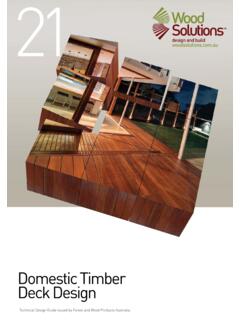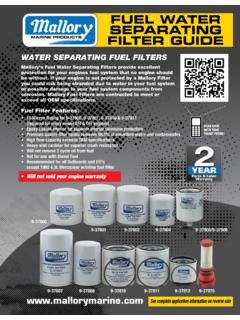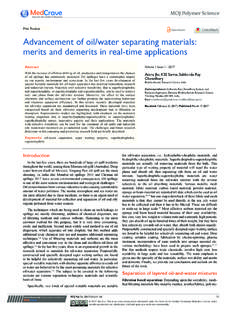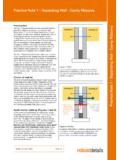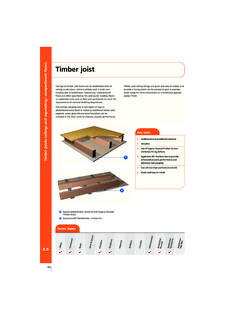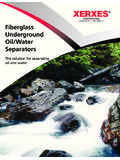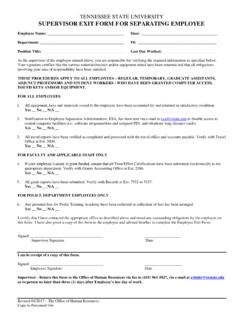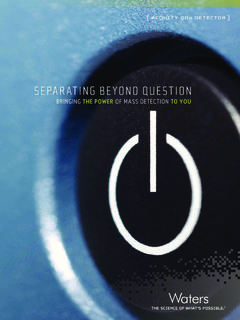Transcription of TECHNICAL DATA SHEET ISSUED BY TIMBER …
1 TIMBER QUEENSLAND LIMITED TECHNICAL DATA SHEET 33 separating walls class 1A BUILDINGS Revised August 2014 Page 1 Fire and sound are important considerations in multi-residential construction. Fire-resisting construction is critical for protecting against extreme events and loss of life while sound insulation tends to influence the choice of construction system because of its daily impact on the building occupants quality of Data SHEET will address some specific issues associated with the design and construction of TIMBER fire separating walls in class 1a Buildings and highlight some of the common installation deficiencies found on building sites.
2 During building audits and also following investigations after fire WALL REQUIREMENTSS eparating walls are used to provide fire-resistance and sound insulation between attached class 1a buildings. Specific requirements pertaining to this include: Must have walls with a Fire Resistance Level (FRL) of not less than 60/60/60. Must commence at the footings or ground slab and extend up according to one of the following scenarios: For a non-combustible roof covering the wall must extend to the underside of the roof.
3 The wall must not be crossed by TIMBER members (or other combustible building elements) other than roof battens (maximum 75 x 50 mm) or sarking. Voids between the top of wall and underside of roofing ( between battens) must be filled with mineral wool or other suitable fire-resisting material. For a combustible roof the wall must extend 450 mm above the roof. Must address potential spread of fire that can potentially occur where the end of a separating wall intersects with a masonry veneer wall and the cavity of the latter walls acts as passage for fire.
4 Here, the cavity must be no greater than 50 mm wide and packed at the wall intersection with fire-resistant mineral wool or other suitable fire-resisting material. The packing must be detailed to meet weatherproofing Eaves, verandahs and similar spaces that are open to the roof space and are common to more than one class 1a dwelling must be separated by a non-combustible vertical lining. For electrical cables, wires, switches, outlets, sockets or the like penetrating a separating wall, the wall at the penetration must achieve a Fire Resistance Level of 60/60/60 and must be tested in accordance with AS and or alternatively, comply with the deemed to satisfy detail given in the NCC - building Code of Australia.
5 Other conditions also apply including the spacing between certain penetrations; the accuracy of installation; the treatment of residual gaps between the wall and electrical fitments/cables; the treatment of cavity spaces behind electrical fitments with fire-resisting materials. FRL OF separating WALLSFor class 1a Buildings, fire separating walls must have a minimum FRL 60/60 of the manufacturers of FRL rated SHEET wall systems (plasterboard or fibre cement) have very specific installation procedures that must be followed including sheeting, SHEET layouts, jointing tapes and compounds, fasteners and fastener spacing and fire and sound rated sealants to perimeters etc.
6 RECOMMENDED PRACTICE // AUGUST 2014 separating walls class 1A BUILDINGSTECHNICAL DATA SHEETISSUED BY TIMBER QUEENSLAND33(DUPLEXES, TOWNHOUSES, ROW HOUSES, TERRACE HOUSES) TIMBER QUEENSLAND LIMITED TECHNICAL DATA SHEET 33 separating walls class 1A BUILDINGS Revised August 2014 Page 2 Refer to the Queensland building Construction Commission (QBCC) for specific requirements regarding licensing, installation and certification requirements for Fire separating and matching from one manufacturers system to another is not permitted.
7 Each individual system will have been specifically tested and certified separating walls FROM GROUND/SLAB TO ROOF separating walls must extend from the ground or a concrete slab up to the underside of a non-combustible roof (metal sheeting or tiles). Refer Figure construction and detailing requirements apply where floors or ceilings intersect with the separating wall and these must be followed to ensure the fire rating integrity of the wall is maintained and is continuous for the full height of the 5 Dwelling 6 Dwelling 7 Dwelling 8 Dwelling 9 Suspended floorSeparating wall continues down to groundSeparating wall continued up to underside of non-combustible roofFire-rated external wall above lower roofFigure 1.
8 FRL separating walls from the ground to the underside of a non-combustible walls THROUGH HIP/VALLEY/DUTCH GABLE ROOFS fire separating walls up through roof sections that contain hips, valleys, Dutch gables and similar result in greater challenges to ensure the integrity of the wall is maintained. To be able to maintain the fire separating integrity of the wall typically requires the roofs to be broken either side of the separating wall and where necessary supported by the fire separating wall. This in turn will render the fire separating wall as loadbearing.
9 Loadbearing fire separating walls are a special case and manufacturers of fire separating wall systems should be consulted to ensure the system proposed to be used will be adequate. MEMBERS CROSSING FIRE separating WALLSC ombustible building elements other than TIMBER roof battens of maximum size 50 x 75 must not cross the separating wall and any voids between battens and roofing must be filled with mineral wool or other suitable fire rated material. See Photograph 1. Photograph 1. Fire damaged unit.
10 Note: gaps between battens filled with mineral wool to prevent fire spread across separating OF separating walls WITH EXTERNAL WALLSW here fire separating walls join external walls , the fire separation must be continuous across any cavities that occur in the external wall brick cavities or cavities formed by battening out for external cladding. Figure 2 shows one method of achieving this with an alternative shown in Photograph 2. Figure 2. Detail of junction between fire separating wall and external B/V wall.

